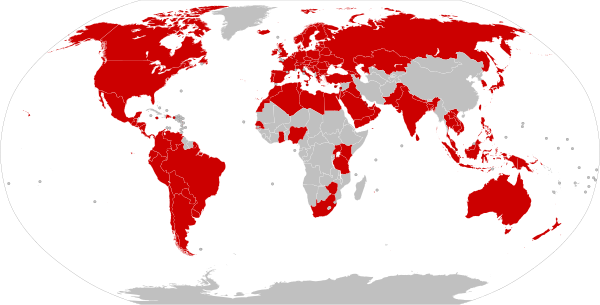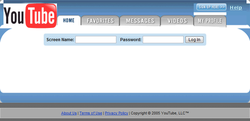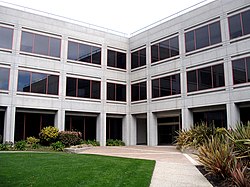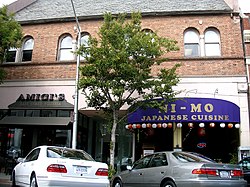as created by three PayPal employees as a video-sharing website where users could upload, share and view content.[1] The Internet domain name "
www.youtube.com" was activated on Monday, February 14, 2005, at 9:13 p.m.[2]Contents
Founding (2005)
YouTube was founded by Chad Hurley, Steve Chen, and Jawed Karim, when they worked for PayPal.[3] Prior to working for PayPal, Hurley studied design at the Indiana University of Pennsylvania; Chen and Karim studied computer science together at the University of Illinois at Urbana–Champaign.[4] YouTube's initial headquarters was above a pizzeria and Japanese restaurant in San Mateo, California.[5]
The domain name "YouTube.com" was activated on February 14, 2005 with video upload options being integrated on April 23, 2005. The first YouTube video, titled Me at the zoo, was uploaded on April 23, 2005, and shows co-founder Jawed Karim at the San Diego Zoo.[7][8]
YouTube began as an angel-funded enterprise working from a makeshift office in a garage. In November 2005, venture firm Sequoia Capital invested an initial $3.5 million,[9] and Roelof Botha (a partner of the firm and former CFO of PayPal) joined the YouTube board of directors. In April 2006, Sequoia and Artis Capital Management invested an additional $8 million in the company, which had experienced significant growth in its first few months.[10]
Growth (2006)
| 2005 | July – Video HTML embedding |
|---|---|
| July – Top videos page | |
| August – 5-star rating system | |
| October – Playlists | |
| October – Full-screen view | |
| October – Subscriptions | |
| 2006 | January – Groups function |
| February – Personalized profiles | |
| March – 10-minute video limit | |
| April – Directors function | |
| May – Video responses | |
| May – Cell phone uploading | |
| June – Further personalized profiles | |
| June – Viewing history | |
| 2007 | June – Local language versions |
| 2008 | March – 480p videos |
| March – Video analytics tool | |
| December – Audioswap | |
| 2009 | January – Google Videos uploading halted |
| July – 720p videos | |
| November – 1080p videos | |
| December – Automatic speech recognition | |
| December – Vevo launch | |
| 2010 | March – "Thumbs" rating system |
| July – 4K video | |
| 2011 | November – YouTube Analytics |
| November – Feature film rental | |
| 2012 | June – Merger with Google Video |
| 2013 | |
| 2014 | October – 60 fps videos |
| 2015 | March – 360° videos |
| November – YouTube Red launches | |
| 2016 | February – YouTube subscription service |
| 2017 | |
| 2018 | |
| 2019 | October - Two ads appear |
During the summer of 2006, YouTube was one of the fastest growing sites on the World Wide Web,[11] hosting more than 65,000 new video uploads. The site delivered an average of 100 million video views per day in July.[12] It was ranked the fifth-most-popular website on Alexa, far out-pacing even MySpace's rate of growth.[13] The website averaged nearly 20 million visitors per month according to Nielsen/NetRatings,[12] with around 44% female and 56% male visitors. The 12- to 17-year-old age group was dominant.[14] YouTube's pre-eminence in the online market was substantial. According to the website Hitwise.com, YouTube commanded up to 64% of the UK online video market.[15]
Purchase by Google (2006)
On October 9, 2006, it was announced that the company would be purchased by Google for US$1.65 billion in stock, which was completed on November 13. At that time it was Google's second-largest acquisition.[17] The agreement between Google and YouTube came after YouTube presented three agreements with media companies in an attempt to avoid copyright-infringement lawsuits. YouTube planned to continue operating independently, with its co-founders and 68 employees working within Google.[18]
Google's February 7, 2007 SEC filing revealed the breakdown of profits for YouTube's investors after the sale to Google. In 2010, Chad Hurley's profit was more than $395 million while Steve Chen's profit was more than $326 million.[19]
Person of the year (2006)
In 2006, Time Magazine featured a YouTube screen with a large mirror as its annual 'Person of the Year'. It cited user-created media such as that posted on YouTube and featured the site's originators along with several content creators. The Wall Street Journal and The New York Times also reviewed posted content on YouTube in 2006, with particular regard to its effects on corporate communications and recruitment. PC World Magazine named YouTube the ninth of its Top 10 Best Products of 2006.[20] In 2007, both Sports Illustrated and Dime Magazine featured positive reviews of a basketball highlight video titled, The Ultimate Pistol Pete Maravich MIX.[21]
Continued growth (2007–present)
It is estimated that in 2007, YouTube consumed as much bandwidth as the entire Internet in 2000.[22]
Originating in 2007, the YouTube Awards are annual awards given out in recognition of the best YouTube videos of the preceding year as voted by the YouTube community.[23]
On July 23, 2007 and November 28, 2007, CNN and YouTube produced televised presidential debates in which Democratic and Republican US presidential hopefuls fielded questions submitted through YouTube.[24][25]
In November 2008, YouTube reached an agreement with MGM, Lions Gate Entertainment, and CBS, allowing the companies to post full-length films and television episodes on the site, accompanied by advertisements in a section for US viewers called "Shows". The move was intended to create competition with websites such as Hulu, which features material from NBC, Fox, and Disney.[26][27]
YouTube was awarded a 2008 Peabody Award and cited as being "a 'Speakers' Corner' that both embodies and promotes democracy".[28][29]
In early 2009, YouTube registered the domain
www.youtube-nocookie.com for videos embedded on United States federal government websites.[30][31] In November of the same year, YouTube launched a version of "Shows" available to UK viewers, offering around 4,000 full-length shows from more than 60 partners.[32]
Entertainment Weekly placed YouTube on its end-of-the-decade "best-of" list In December 2009, describing it as: "Providing a safe home for piano-playing cats, celeb goof-ups, and overzealous lip-synchers since 2005."[33]
In January 2010,[34] YouTube introduced an online film rentals service which is currently available only to users in the US, Canada and the UK.[35][36] The service offers over 6,000 films.[37] In March 2010 YouTube began free streaming of certain content, including 60 cricket matches of the Indian Premier League. According to YouTube, this was the first worldwide free online broadcast of a major sporting event.[38]
On March 31, 2010, YouTube launched a new design with the aim of simplifying the interface and increasing the time users spend on the site. Google product manager Shiva Rajaraman commented: "We really felt like we needed to step back and remove the clutter."[39] In May 2010, it was reported that YouTube was serving more than two billion videos a day, which was "nearly double the prime-time audience of all three major US television networks combined".[40] In May 2011, YouTube reported on the company blog that the site was receiving more than three billion views per day.[41] In January 2012, YouTube stated that the figure had increased to four billion videos streamed per day.[42]
According to May 2010 data published by market research company comScore, YouTube was the dominant provider of online video in the United States, with a market share of roughly 43 percent and more than 14 billion videos viewed during May.[43]
In October 2010, Hurley announced that he would be stepping down as the chief executive officer of YouTube to take an advisory role, with Salar Kamangar taking over as the head of the company.[44]
James Zern, a YouTube software engineer, revealed in April 2011 that 30 percent of videos accounted for 99 percent of views on the site.[45]
During November 2011, the Google+ social networking site was integrated directly with YouTube and the Chrome web browser, allowing YouTube videos to be viewed from within the Google+ interface.[46] In December 2011, YouTube launched a new version of the site interface, with the video channels displayed in a central column on the home page, similar to the news feeds of social networking sites.[47] At the same time, a new version of the YouTube logo was introduced with a darker shade of red, which was the first change in design since October 2006.[48]
In 2012, YouTube said that roughly 60 hours of new videos are uploaded to the site every minute, and that around three-quarters of the material comes from outside the U.S.[41][42][49] The site has eight hundred million unique users a month.[50]
Starting from 2010 and continuing to the present, Alexa ranked YouTube as the third most visited website on the Internet after Google and Facebook.[51]
In late 2011 and early 2012, YouTube launched over 100 "premium" or "original" channels. It was reported the initiative cost $100 million.[52] Two years later, in November 2013, it was documented that the landing page of the original channels became a 404 error page.[53][54] Despite this, original channels such as SourceFed and Crash Course were able to become successful.[55][56]
An algorithm change was made in 2012 that replaced the view-based system for a watch time-based one that is credited for causing a surge in the popularity of gaming channels.[57]
In October 2012, for the first-time ever, YouTube offered a live stream of the U.S. presidential debate and partnered with ABC News to do so.[58]
On October 25, 2012, The YouTube slogan (Broadcast Yourself) was taken down due to the live stream of the U.S. presidential debate.
YouTube relaunched its design and layout on December 4, 2012 to be very similar to the mobile and tablet app version of the site. On December 21, 2012, Gangnam Style became the first YouTube video to surpass one billion views.[59]
In March 2013, the number of unique users visiting YouTube every month reached 1 billion.[60] In the same year, YouTube continued to reach out to mainstream media, launching YouTube Comedy Week and the YouTube Music Awards.[61][62] Both events were met with negative to mixed reception.[63][64][65][66] In November 2013, YouTube's own YouTube channel had surpassed Felix Kjellberg's PewDiePie channel to become the most subscribed channel on the website. This was due to auto-suggesting new users to subscribe to the channel upon registration.[67]
Internationalization
On June 19, 2007, Google CEO Eric Schmidt was in Paris to launch the new localization system.[69] The interface of the website is available with localized versions in 89 countries, one territory (Hong Kong) and a worldwide version.[70]
 | ||||
| Country | Language(s) | Launch date | Notes | |
|---|---|---|---|---|
| English | February 15, 2005[69] | First location | ||
| Portuguese | June 19, 2007[69] | First international location | ||
| French, and Basque | June 19, 2007[69] | |||
| English | June 19, 2007[69] | |||
| Italian | June 19, 2007[69] | |||
| Japanese | June 19, 2007[69] | |||
| Dutch | June 19, 2007[69] | |||
| Polish | June 19, 2007[69] | |||
| Spanish, Galician, Catalan, and Basque | June 19, 2007[69] | |||
| English | June 19, 2007[69] | Expansion continues | ||
| Spanish | October 11, 2007[71] | |||
| Chinese, and English | October 17, 2007[72] | Blocked in China | ||
| Chinese | October 18, 2007[73] | |||
| English | October 22, 2007[74] | |||
| English | October 22, 2007[74] | |||
| French, and English | November 6, 2007[75] | |||
| German | November 8, 2007[76] | |||
| Russian | November 13, 2007[77] | |||
| Korean | January 23, 2008[78] | First launch in 2008 | ||
| Hindi, Bengali, English, Gujarati, Kannada, Malayalam, Marathi, Tamil, Telugu, and Urdu | May 7, 2008[79] | |||
| Hebrew | September 16, 2008 | |||
| Czech | October 9, 2008[80] | |||
| Swedish | October 22, 2008[81] | Location never launched in 2009 | ||
| Afrikaans, Zulu, and English | May 17, 2010[69] | First African location | ||
| Spanish | September 8, 2010[82] | |||
| French, and Arabic | March 9, 2011[83] | |||
| Arabic | March 9, 2011[83] | |||
| Arabic | March 9, 2011[83] | |||
| French, and Arabic | March 9, 2011[83] | |||
| Arabic | March 9, 2011[83] | |||
| French, and Arabic | March 9, 2011[83] | |||
| Arabic | March 9, 2011[83] | |||
| Swahili, and English | September 1, 2011[84] | |||
| Filipino, and English | October 13, 2011[85] | |||
| English, Malay, Chinese, and Tamil | October 20, 2011[86] | |||
| French, Dutch, and German | November 16, 2011[69] | Middle location | ||
| Spanish | November 30, 2011[87] | |||
| English | December 2, 2011[88] | Needs a Swahili edition for the country | ||
| English | December 7, 2011[89] | |||
| Spanish | January 20, 2012[90] | First location in 2012 | ||
| Hungarian | February 29, 2012[91] | |||
| Malay, and English | March 22, 2012[92] | |||
| Spanish | March 25, 2012[93] | |||
| Arabic, and English | April 1, 2012[94] | |||
| Greek | May 1, 2012 | |||
| Indonesian, and English | May 17, 2012[95] | |||
| English | June 5, 2012[96] | |||
| French, and English | July 4, 2012[97] | |||
| Turkish | October 1, 2012[98] | |||
| Ukrainian | December 13, 2012[99] | |||
| Danish | February 1, 2013[100] | |||
| Finnish, and Swedish | February 1, 2013[101] | |||
| Norwegian | February 1, 2013[102] | |||
| German, French, and Italian | March 29, 2013[103] | |||
| German | March 29, 2013[104] | Long-waited launch | ||
| Romanian | April 18, 2013[105] | |||
| Portuguese | April 25, 2013[106] | Long-waited launch | ||
| Slovak | April 25, 2013[107] | |||
| Arabic | August 16, 2013[108] | Multiple Middle East locations launched | ||
| Arabic | August 16, 2013[108] | |||
| Arabic | August 16, 2013[108] | |||
| Arabic | August 16, 2013[108] | |||
| Bosnian, Croatian, and Serbian | March 17, 2014 | |||
| Bulgarian | March 17, 2014[109] | |||
| Croatian | March 17, 2014[110] | |||
| Estonian | March 17, 2014[111] | |||
| Latvian | March 17, 2014[112] | |||
| Lithuanian | March 17, 2014 | Baltic area fully locally accessible | ||
| Macedonian, Serbian, and Turkish | March 17, 2014 | |||
| Serbian, and Croatian | March 17, 2014 | |||
| Serbian | March 17, 2014 | |||
| Slovenian | March 17, 2014[113] | |||
| Thai | April 1, 2014[114] | |||
| Arabic | May 1, 2014[108] | |||
| Spanish, and English | August 23, 2014 | Use Spain version or USA version before launch. | ||
| Icelandic | ?, 2014 | |||
| French, and German | ?, 2014 | |||
| Vietnamese | October 1, 2014 | |||
| Arabic | February 1, 2015 | Blocked in 2010, but unblocked in 2011. | ||
| Swahili, and English | June 2, 2015 | |||
| English | June 2, 2015 | |||
| Azerbaijani | October 12, 2015[115] | |||
| Russian | October 12, 2015[115] | |||
| Georgian | October 12, 2015[115] | |||
| Kazakh | October 12, 2015[115] | |||
| Arabic | November 9, 2015[citation needed] | |||
| Nepali | January 12, 2016[116] | |||
| Urdu, and English | January 12, 2016[117] | Blocked in 2012 but unblocked in 2015 | ||
| Sinhala, and Tamil | January 12, 2016[118] | |||
| English | August 4, 2016[citation needed] | |||
| English | June 24, 2018 | |||
| Spanish | January 30, 2019 | |||
| Spanish | January 30, 2019 | |||
| Spanish | January 30, 2019 | |||
| Spanish | January 30, 2019 | |||
| Spanish | January 30, 2019 | |||
| Spanish | January 30, 2019 | |||
| Spanish | January 30, 2019 | |||
| Spanish | January 30, 2019 | |||
| Spanish | January 30, 2019 | |||
| Spanish and Guarani | February 21, 2019 | |||
| Spanish | February 21, 2019 | |||
| Greek and Turkish | March 13, 2019 | |||
| German | March 13, 2019 | |||
Google aims to compete with local video-sharing websites like Dailymotion in France. It also made an agreement with local television stations like M6 and France Télévisions to legally broadcast video content.[citation needed]
On October 17, 2007, it was announced that a Hong Kong version had been launched. YouTube's Steve Chen said its next target will be Taiwan.[119][120]
YouTube was blocked from Mainland China from October 18 due to the censorship of the Taiwanese flag.[121] URLs to YouTube were redirected to China's own search engine, Baidu. It was subsequently unblocked on October 31.[122]
The YouTube interface suggests which local version should be chosen on the basis of the IP address of the user. In some cases, the message "This video is not available in your country" may appear because of copyright restrictions or inappropriate content.[123] The interface of the YouTube website is available in 76 language versions, including Amharic, Albanian, Armenian, Bengali, Burmese, Khmer, Kyrgyz, Laotian, Mongolian, Persian and Uzbek, which do not have local channel versions.[124] Access to YouTube was blocked in Turkey between 2008 and 2010, following controversy over the posting of videos deemed insulting to Mustafa Kemal Atatürk and some material offensive to Muslims.[125][126] In October 2012, a local version of YouTube was launched in Turkey, with the domain
youtube.com.tr. The local version is subject to the content regulations found in Turkish law.[127] In March 2009, a dispute between YouTube and the British royalty collection agency PRS for Music led to premium music videos being blocked for YouTube users in the United Kingdom. The removal of videos posted by the major record companies occurred after failure to reach agreement on a licensing deal. The dispute was resolved in September 2009.[128] In April 2009, a similar dispute led to the removal of premium music videos for users in Germany.[129]Business model, advertising, and profits
Before being purchased by Google, YouTube declared that its business model was advertisement-based, making 15 million dollars per month.
Google did not provide detailed figures for YouTube's running costs, and YouTube's revenues in 2007 were noted as "not material" in a regulatory filing.[130] In June 2008, a Forbes magazine article projected the 2008 revenue at $200 million, noting progress in advertising sales.[131]
Some industry commentators have speculated that YouTube's running costs (specifically the network bandwidth required) might be as high as 5 to 6 million dollars per month,[132] thereby fuelling criticisms that the company, like many Internet startups, did not have a viably implemented business model. Advertisements were launched on the site beginning in March 2006. In April, YouTube started using Google AdSense.[133] YouTube subsequently stopped using AdSense but has resumed in local regions.
Advertising is YouTube's central mechanism for gaining revenue. This issue has also been taken up in scientific analysis. Don Tapscott and Anthony D. Williams argue in their book Wikinomics that YouTube is an example for an economy that is based on mass collaboration and makes use of the Internet.
- "Whether your business is closer to Boeing or P&G, or more like YouTube or flickr, there are vast pools of external talent that you can tap with the right approach. Companies that adopt these models can drive important changes in their industries and rewrite the rules of competition"[134]:270 "new business models for open content will not come from traditional media establishments, but from companies such as Google, Yahoo, and YouTube. This new generation of companies is not burned by the legacies that inhibit the publishing incumbents, so they can be much more agile in responding to customer demands. More important, they understand that you don't need to control the quantity and destiny of bits if they can provide compelling venues in which people build communities around sharing and remixing content. Free content is just the lure on which they layer revenue from advertising and premium services".[134]:271sq
Tapscott and Williams argue that it is important for new media companies to find ways to make a profit with the help of peer-produced content. The new Internet economy, (that they term Wikinomics) would be based on the principles of "openness, peering, sharing, and acting globally". Companies could make use of these principles in order to gain profit with the help of Web 2.0 applications: "Companies can design and assemble products with their customers, and in some cases customers can do the majority of the value creation".[134]:289sq Tapscott and Williams argue that the outcome will be an economic democracy.
There are other views in the debate that agree with Tapscott and Williams that it is increasingly based on harnessing open source/content, networking, sharing, and peering, but they argue that the result is not an economic democracy, but a subtle form and deepening of exploitation, in which labour costs are reduced by Internet-based global outsourcing.
The second view is e.g. taken by Christian Fuchs in his book "Internet and Society". He argues that YouTube is an example of a business model that is based on combining the gift with the commodity. The first is free, the second yields profit. The novel aspect of this business strategy is that it combines what seems at first to be different, the gift and the commodity. YouTube would give free access to its users, the more users, the more profit it can potentially make because it can in principle increase advertisement rates and will gain further interest of advertisers.[135] YouTube would sell its audience that it gains by free access to its advertising customers.[135]:181
- "Commodified Internet spaces are always profit-oriented, but the goods they provide are not necessarily exchange-value and market-oriented; in some cases (such as Google, Yahoo, MySpace, YouTube, Netscape), free goods or platforms are provided as gifts in order to drive up the number of users so that high advertisement rates can be charged in order to achieve profit."[135]:181
In June 2009, BusinessWeek reported that, according to San Francisco-based IT consulting company RampRate, YouTube was far closer to profitability than previous reports, including the April 2009, projection by investment bank Credit Suisse estimating YouTube would lose as much as $470 million in 2009.[136] RampRate's report pegged that number at no more than $174 million.[137]






Social Plugin